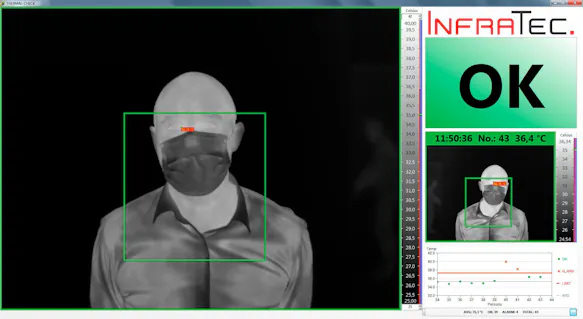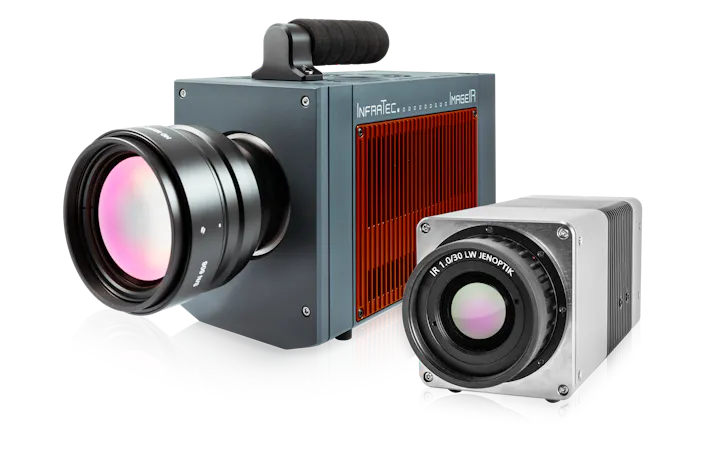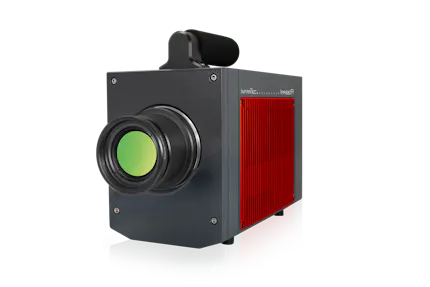IR-based Detection of Elevated Body Temperature for Coronavirus, SARS, Ebola
Use Infrared Cameras for Temperature Scanning
Major travel hubs like airports, seaports, railway stations and long-distance bus stations are one of the points on which the security measures of public authorities are aimed when infectious diseases such as
Coronavirus (2019-nCoV, COVID-19, SARS-CoV-2)
Severe Acute Respiratory Syndrome (SARS)
Ebola Virus Disease (EVD)
Middle East Respiratory Syndrome Coronavirus (MERS-CoV)
cause global problems. From there, diseases can be effectively prevented from spreading further.
InfraTec infrared cameras can be used for a corresponding elevated body temperature scanning of passengers, employee scanning and workplace entrance screening. Certainly, thermographic cameras can neither detect the virus itself nor a person carrying the virus! However, these cameras enable the precise non-reactive, contactless and planar recording of surface temperatures while using the technical temperature measurement technology known as thermography. Hence, they are highly suitable for the quick and easy detection of elevated body temperatures, which can be an indication of a possible virus infection of people subjected to screening.

The body temperature preferably is detected at the inner angle of the eye with the infrared camera. Slightest differences and thus abnormal body temperatures can be displayed and will result in alarms. Performing such health screenings, e.g. via implementing temperature checkpoints for example for employee screening, enable the acquisition of important information as a basis for decision-making for subsequent medical examinations of the selected people and thus serve to secure public areas.
Such indications must, of course, always be followed by other examination methods that allow a reliable positive or negative statement about the disease and to initiate appropriate actions!
THERMAL-CHECK at a Glance
Reliable detection of persons with elevated body temperature
Compliance with data protection guidelines: no collection of biometric data or ID cards, no comparison with personal registers
Screening of several people at the same time, even when moving, with consistently high measurement accuracy
High-resolution, repeatable measurement technology thanks to high geometrical and thermal resolution with at least (640 x 480) IR pixels for absolute precision
Camera can be used flexibly for other measuring tasks, e.g. in research and development, quality assurance, etc.

Infrared Cameras are not Medical Diagnostic Instruments for Fever Detection but Technical Measuring Devices for Temperature Scanning of People
The term “detecting a fever“ in the sense of a (medical) fever diagnosis is actually not permitted as a designation for the above-mentioned thermographic recording of elevated body temperatures with thermal cameras under strict observation: One reason is that fever is a complex medical phenomenon. The other reason is that, from a purely formal point of view, the cameras used are “only“ technical measuring devices and not medical diagnostic instruments.
What Solutions Does InfraTec Offer to Detect Elevated Body Temperature?
InfraTec provides complete, ready to use solutions tailored to the detection of elevated body temperature. Our cameras offer high thermal and spatial resolution making them faster and more reliable than those using low resolution. The camera combined with our application specific software, display and control computer and a tripod is all you need to get you started. Packages are based on the following core components depending on your choices:
Thermal cameras of the series VarioCAM® High Definition, VarioCAM® HDx or PIR uc 605
Excellent thermal resolution up to 0.02 K
Measurement accuracy in special HiPrec mode up to ± 0.8 K
Geometric resolution up to (1,024 × 768) IR pixels (XGA) allowing for multiple‐person screening
Thermography software THERMAL‐CHECK
Automatic optical and optionally acoustic alarm
Algorithm‐based accuracy up to ± 0.3 K
In the selectable automatic mode the system will automatically detect if a person is facing the camera and take a measurement of the body temperature
Accessories for a direct start
Tripod to mount the camera
Laptop to configure and control the system and for reporting (with configurable privacy settings)
Comprehensive InfraTec service
24‐hour service hotline
Warranty up to 48 months
Software update service free of charge for up to 36 months
Upgrade options for using the camera system for other measurement tasks
Further Information about THERMAL-CHECK from InfraTec
Download the white paper to get further information about THERMAL-CHECK.

Which Advantages Does the InfraTec Solution also Offer When Detecting Elevated Body Temperature?
Contactless and planar temperature measurement without external reference radiator
Parallel checking of multiple people is possible, faces at different heights (children for example)
Having the largest number of pixels our system can screen multiple people at the same time, faces at different heights (children for example) or distances from the camera. Only the high number of pixels gives you the same reliability over a larger field of view as required in the specifications for the size of the optimal measurement area according to IEC 80601‐2‐59
Resolution also of smaller areas of the skin (angle of the eye) from a safe distance
Up to ± 0.3 K measurement accuracy due to adjustable temperature difference thresholds using the reference image algorithm of the THERMAL-CHECK software
Excellent thermal resolution of up to 0.02 K
Display and evaluation in real time
Reliable temperature measurements based on low noise infrared detectors and precision calibration
Alarming at surpassing temperature thresholds
Storage of individual settings for detection of elevated body temperature
Easily installable all-in-one unit for continuous monitoring of persons and groups of people
Solutions for stationary and handheld use available
Fitting to larger external digital displays via HDMI*
Achieve Reliable Measurement Results for Detection of Elevated Body Temperature
The thermographic temperature measurement for detection of elevated body temperature puts high demands on suitable thermal cameras: In addition to a high thermal resolution, which can make even the smallest temperature differences visible, there must be very good stability and measuring accuracy in order to be able to reliably distinguish a person with an elevated body temperature from a person without these symptoms using critical temperature thresholds and alarm values.

Another very important criterion is the required high geometric resolution, which is expressed in the number of so-called infrared (IR) pixels. This is necessary because the area that has been proven in several studies to be suitable for reliably detecting elevated body temperature at the inner eyelid angle has only a small surface area, but must be sharply mapped for error-free temperature measurement.
The measurement itself takes less than a second and is usually carried out in access areas, for example at the entry control at airports, where the people who are to be screened are already lined up. Largely determined by the wide-ranging requirements of the users, the evaluation of the measured data can range from simple manual use to select people with elevated body temperature for further examinations to automatic detection and storage.

Would You Like to Know More?
It is not unusual for tasks to be associated with special requirements. Discuss your specific application needs with our specialists, receive further technical information or learn more about our additional services.
How Is the Thermographic Screening Proceeded?
The thermal camera and software are ready for use in just a few steps. Here, measurement distances, which result from the device configuration, have to be kept exactly in order to avoid errors during screening itself and thus to be able to achieve a reliable result.
1. Choosing a Suitable Screening Position
The screening must be carried out in an indoor environment with constant room temperature
The persons to be screened should stand in front of a homogeneous, matt surface at room temperature (for example panel wall or fabric)
2. Setting Up the System
The thermal camera is mounted on the tripod according to the maximum distances to be observed (see information on configuration)
Determining the correct measurement distance to the person (placing a floor marker for orientation)

Legend
1 Thermal camera on tripod
2 Monitor with result display
3 Distance from the camera to the person
4 Field of view of the camera (VGA: up to 64 cm (25 inches), XGA: up to 102 cm (45 inches))
5 Position of the person
6 Background (matt) optimal to prevent interference radiation from the environment
7 Control plane with fixed distance to the camera lens
3. Powering Up the System
Turn on the thermal camera approximately 30 minutes prior to use for optimal equilibrium
Connect the thermal camera to the computer (included in the scope of delivery depending on the package) according to the instructions
Start the THERMAL‐CHECK software
4. Confirm or Configure the Alarm Set Points

5. Start of the Screening Process

6. If the Temperature is Above the Alarm Set Point
The result part of the screen will turn red and depending on your configuration additional audio‐visual alarms may be triggered.

Thermographic Screening for the Detection of Elevated Body Temperatures in Detail
Certainly, thermal cameras can neither detect a virus itself nor whether a person is carrying a virus! However, these cameras enable the precise non‐reactive, contactless measurement of surface temperatures while using the technical temperature measurement technology known as thermography or thermal imaging. Hence, they are highly suitable for the quick and easy detection of elevated body temperatures, which can be an indication of a possible virus infection. Such indications must, of course, always be followed by other examination methods that allow a reliable positive or negative statement about the disease and to initiate appropriate actions! The term "detecting a fever" in the sense of a (medical) fever diagnosis is actually not permitted as a designation for the above‐mentioned thermographic recording of elevated body temperatures with thermal cameras under strict observation: One reason is that fever is a complex medical phenomenon. The other reason is that, from a purely formal point of view, the cameras used are “only“ technical measuring devices and not medical diagnostic instruments.
Thermography systems measure surface temperatures based on the emitted heat radiation, for example the temperature of the human skin surface. However, this is different from the internal body temperature, the so‐called body core temperature. The temperature of the skin surface depends on the ambient temperature (summer, winter, direct sunlight, and so on). In addition, a light film of water can produce evaporative cooling due to perspiration. Furthermore, beards, haircuts, face masks, etc. cause many areas of the skin on the face to be optically "covered" and the heat radiation cannot reach the camera unhindered. Thus, the skin surface in most parts of the face is rather unsuitable for reliable and repeatable thermographic temperature measurement.
Only a few regions on the head are really useful for thermographic screening:
The auditory canal
It displays the body core temperature very well and is used for non‐contact temperature measurement with manually applied so‐called ear thermometers, which are approved as medical diagnostic instruments. However, measurement by thermography is not practical, as the test person would have to be positioned very precisely in relation to the camera and, in addition, the ear canal is often covered by the hairstyle.

The oral cavity
It is in principle very suitable. In this case, however, the test persons would have to position themselves in front of the thermal camera with their mouths wide open, which is not effective in terms of hygiene.
The eye region
Especially that part where the tear ducts are located, just below these small areas, strong blood vessels ensure a temperature that is very close to the core body temperature. Their excellent suitability for detecting elevated body temperature by means of frontal thermography of the facial area has been proven in several studies. However, they are only a few mm
InfraTec, therefore, consistently uses thermographic temperature measurement at the inner eyelid corner for the detection of elevated body temperature as the demonstrably safest and most reliable method for thermal screening.
The Following Requirements are Essential
A) Requirements for the geometrical resolution of thermal cameras
Since the regions to be measured each have a dimension of approximately (3 × 3) mm² (0.014 square inches), a high spatial resolution of 1 mm
A sufficiently large field of view is necessary to capture people of different heights without the need to constantly move the camera. This requires a certain minimum number of measurement pixels or minimum detector formats. According to IEC 80601‐2‐59, the detector of the thermal camera must have at least (320 × 240) measurement pixels, whereby the face of the test person must be covered with at least (240 × 180) pixels (here approximately 56 % of all measurement pixels). In this case, the camera would have to be repeatedly moved by hand or people would have to get on and off a step in order to be able to take a measurement.
Considerably higher flexibility is offered by more powerful thermal cameras with considerably more than (320 × 240) measuring pixels. These enable a sufficiently large field of view (FOV), for example to take thermographs of several people at the same time. This also ensures that the facial area or the eyelid angle of each individual subject is still filled with enough measurement pixels to have a good measurement in a reasonable time.
In order to meet the criterion of high spatial resolution required by the international standard, InfraTec offers the following preferred configurations (assuming 20 cm (8 inches) to be the width of the face being screened):
| Thermal camera (Detector format) | Opening angle | Possible measurement range (A) | FOV (B) | Filled FOV width by face area |
|---|---|---|---|---|
| PIR uc 605 / Standard lens (640 × 480) | (32.9 × 24.2)° | ≤ 1.1 m / ≤ (3.6) feet | ≤ (63 × 47) cm / ≤ (25 × 19) inches | approx. 31 % |
| PIR uc 605 / Telephoto lens (640 × 480) | (12.4 × 9.3)° | ≤ 3.0 m / ≤ (9.8) feet | ≤ (65 × 49) cm / ≤ (26 × 19) inches | approx. 31 % |
| VarioCAM® HDx / Standard lens (640 × 480) | (30.4 × 23.1)° | ≤ 1.17 m / ≤ (3.84) feet | ≤ (64 × 48) cm / ≤ (25 × 19) inches | approx. 31 % |
| VarioCAM® HDx / Telephoto lens (640 × 480) | (15.5 × 11.6)° | ≤ 2.35 m / ≤ (7.71) feet | ≤ (64 × 48) cm / ≤ (25 × 19) inches | approx. 31 % |
| VarioCAM® High Definition / Standard lens (1,024 × 768) | (32.4 × 24.6)° | ≤ 1.76 m / ≤ (5.77) feet | ≤ (102 × 77) cm / ≤ (40 × 30) inches | approx. 20 % / 2 persons per camera possible |
| VarioCAM® High Definition / Telephoto lens (1,024 × 768) | (16.5 × 12.4)° | ≤ 3.52 m / ≤ (11.55) feet | ≤ (102 × 77) cm / ≤ (40 × 30) inches | approx. 20 % / 2 persons per camera possible |
This overview illustrates that with larger detector formats, there is more flexibility with regard to the number of persons that can be screened at the same time and their height (for example, (1.5 ... 2) m ((4.9 … 6.6) feet)), without having to constantly reposition the camera to meet the criterion of the required spatial resolution. To achieve more flexibility with regard to different person sizes it would also be conceivable to tilt the camera by 90° to get more pixel in the vertical. The measurement distance can, of course, be further reduced within the bounds of possibility in order to improve the spatial resolution. However, the field of view will then become correspondingly smaller and the demands on the lateral placement of the test persons will increase. The angle of incidence, which determines the relationship between the measurement distance and the field of view size, can be varied by selecting the IR lens. Compared to telephoto lenses, standard InfraTec lenses offer the advantage of a larger field of view as well as a larger depth of field, which makes it easier to keep the permissible tolerances of the measurement distance, thus ensuring a smoother screening process and higher throughput. The correct distances of the person to the lens of the selected camera can be taken from the values in table columns A and B. With the VarioCAM® High Definition, two persons can be screened at the same time due to the larger field of view (important: additional partition wall absolutely necessary).


Legend
1 Thermal camera on tripod
2 Distance from the camera to the person
3 Horizontal field of view of the camera
4 Position of the person/two persons (only possible with partition wall using VarioCAM® High Definition with XGA resolution)
5 Portable partition wall (matt) for shielding from interference radiation from the environment
B) How accurately can thermographic systems be used to measure an elevated body temperature?
Usually, absolute temperature measurement accuracies of thermographic systems are specified to ± 2 K or ± 2 % under the assumption of black body measurement and to ± 1 K or ± 1 % for very good systems. This measurement uncertainty is related to the operating temperature range of the camera, which is often specified as (‐20 ... 50) °C / (‐4 … 122) F. In room temperature environments and in restricted measurement ranges, they are much more precise (up to ± 0.8 K in HiPrec mode), but not as accurate as, for example, contact thermometers.
Solutions from InfraTec with optimised measurement accuracy: Comparative analysis, for which InfraTec systems are ideally suited, is one way of further improving measurement accuracy. With the help of the innovative thermography software THERMAL‐CHECK the moving average or median of the measured temperatures of the inner eyelid angles of the last for example 10 test persons without detected increased body temperature is continuously determined and used as a reference. This is based on the fact that test persons with elevated body temperature are a rare exception, whereas inconspicuous test persons include the objectively occurring environmental variations to which all test persons are subject in the reference. In addition, the user (operator) defines a temperature threshold of for example (1 ... 2) K above this reference value, and if this temperature threshold is exceeded, a corresponding message or alarm is issued. This comparative analysis has proven to be very robust under practical conditions. If a person should have a correspondingly higher temperature, this is reliably detected (up to ± 0.3 K accuracy). This method can be practiced with InfraTec's high‐quality thermal camera series VarioCAM® High Definition without additional aids such as reference temperature radiators.
Comfortable Software Package THERMAL-CHECK
Besides the infrared camera, application-specific software also plays an important role. The THERMAL-CHECK software of InfraTec offers all the functionality needed for the detection of elevated body temperature in various scenarios and is still intuitively usable. It reliably determines the small area of the human face where reliable body temperature determination is possible.
Automatic optical and optionally acoustic alarm
Algorithm-based measurement accuracy of to ± 0.3 K
Convenient camera remote control
Individual configurations of alarms and external information displays or monitors
“Anonymous mode“ selectable for data protection

Temperature in the range of the alarm setpoint
The screening will start automatically. As soon as a (test) person’s face is in the marked area (inner green frame), the measurement is performed.

Temperature above the alarm set point
The result part of the screen will turn red and depending on your configuration additional audio-visual alarms may be triggered.
InfraTec – Specialist for Infrared and Thermal Imaging Technology
InfraTec has been developing, producing and selling modern infrared technology for more than 30 years now. In addition to thermographic cameras, this includes turnkey thermographic automation solutions, infrared precision lenses, OEM components, software and a wide range of accessories. With more than 30 sales partners, the Dresden-based company is one of the world's leading suppliers of commercial thermography and thermal imaging systems. This enables customers to solve even the most demanding measurement and testing tasks in areas such as process optimization, quality assurance, research and development and material testing. In addition, InfraTec offers users a comprehensive range of services. This includes, for example, expert advice on the selection of technology, a calibration service and personnel training on the introduction of thermal imaging technology.
















